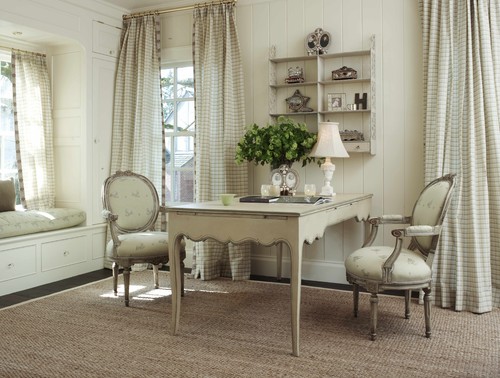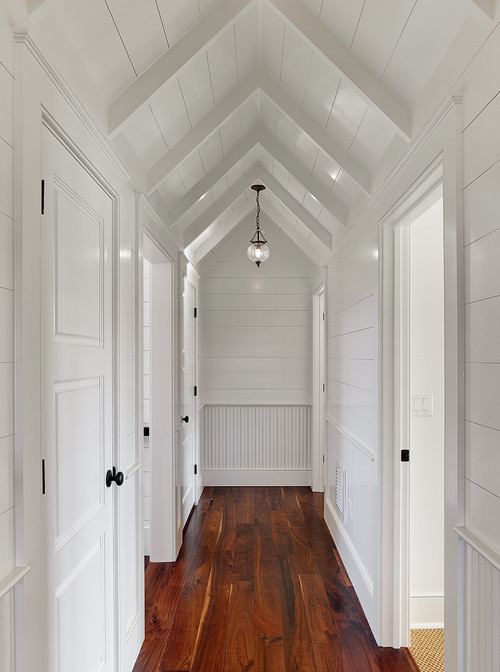Have you ever wondered if it is okay to mix paneling styles? I always remind my clients that designers don't follow "rules" -- they apply design principles and psychology and creativity.
You can mix paneling, but it should be done thoughtfully.In the picture below, three different paneling applications are used very successfully. The roof decking is a narrower tongue and groove, while the dormer is defined by a wider planking. The cabinet end panels have stiles and rails, with a center panel. The human scale of the seating area is defined by a vertical application of the same tongue and groove used for the roof decking.
This mix of paneling styles works for several reasons. First, the designers created variety by mixing styles -- a sea of only one type of paneling might have looked boring. The designers created unity through the use of one color. The designers also used the orientation of the the boards to define the space, emphasize human scale, and to highlight important architectural features.
In this next picture, the designer used two different paneling styles. By painting the upper portion an earthy green, the designer made the entry area feel cozy and homey. Interest is added to the board and batten treatment with diagonal "cross-bracing" that makes you feel like you've stepped onto a country farm.
The kitchen shown here, by Sarah Richardson, has three different types of paneling. The walls and ceiling are whitewashed tongue and groove, one of the end panels is flat, and the peninsula end and back panels are made with reclaimed wood. It's eclectic, but restrained. The gray in the reclaimed wood is repeated in the tile color, which brings cohesion, or unity.
The lovely space below has two types of paneling -- vertical tongue and groove on the walls, and stile and rail panels defining the window seat area. The subtle texture, combined with the soft white and gray color scheme make this space feel peaceful. I would love to curl up in that window seat with a cup of tea, wouldn't you?
This hallway has the roof decking repeated on the upper portion of the wall, while the area below the chair rail -- the dado -- has narrower tongue and groove applied vertically. It's a great way to add interest by creating rhythm and variety. Unity is achieved through the use of only one color.
The space below shows a casual mix of vertical and horizontal paneling.
Here is a similar application of horizontal and vertical paneling. It's not quite as rustic as the above picture, but still very comfortable and casual.
The folks at Hiya Papaya have the eclectic mixing of paneling down to an art form! The use of reclaimed wood in the entry keeps a traditional house from feeling too stuffy. From one vantage point, you can see both reclaimed wood and traditional board and batten. The reclaimed wood defines the entry and sets an eclectic and casual tone for the home, while the more traditional paneling keeps things from getting too crazy! This is a beautiful home and you really, really, really, need to follow the link to see more pictures!
Would you mix paneling types in your home?









